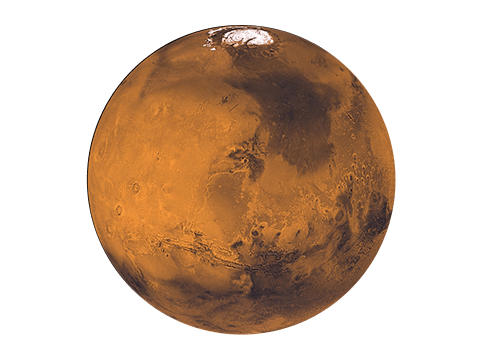Mars is the fourth planet from the Sun and the second-smallest planet with a thin atmosphere, having the surface features reminiscent both of the impact craters of the Moon, and the valleys, deserts and polar ice caps of Earth. It is the most widely searched planet for life.
Keys Facts & Summary
- Due to its brightness and closeness to Earth, Mars has been documented for at least 4.000 years thus it is impossible to credit someone with its discovery. However, the first person to observe Mars with a telescope was Galileo Galilei in 1610.
- It is named after the Roman god of war due to its red appearance. In different cultures, Mars represents masculinity, youth and its symbol is used as the symbol for the male gender.
- Due to the effects of the iron oxide prevalent on Mars’s surface, it has a reddish appearance distinctive among the astronomical bodies visible to the naked eye.
- It is a terrestrial planet with a thin atmosphere, having surface features reminiscent of both the impact craters of Earth’s Moon, and the valleys, deserts and polar ice caps of Earth.
- Mars is 227.9 million km / 141.6 million mi or 1.5 AU away from the Sun. It takes sunlight about 13 minutes to reach Mars.
- The farthest distance from Earth is 401 million km / 249 million mi, and its closest distance to us can be 54.6 million km / 34 million mi, while the average distance is 225 million km / 140 million mi.
Mars
Mars has been observed by many different cultures from around the world since hundreds of years. Because of this it is impossible to credit anyone with its discovery, Mars being easily visible with the naked eye.
To the ancient Romans, the planet Mars was symbolic of blood and war, the equivalent of the Greek god of war Aries. In the 16th century, Nicolaus Copernicus proposed a heliocentric model for the Solar System in which the planets follow circular orbits around the Sun.
Johannes Kepler revised this creation, yielding an elliptic orbit for Mars that more accurately fitted the observational data. In 1610, Galileo Galilei first observed Mars with a telescope and within a century, astronomers discovered several features of Mars and determined the planet’s rotational period and axial tilt.
Formation
It is hypothesized that the Solar System formed from a giant rotating ball of gas and dust known as the pre-solar nebula. Much of it formed the Sun while more of its dust went on and merged to create the first proto-planets. Mars was one of these planets and after the gravity pulled enough swirling gas and dust, it became the fourth planet from the Sun.
Distance, Size and Mass
Mars is about 227.9 million km / 141.6 million mi or 1.5 AU away from the Sun. It takes sunlight about 13 minutes to reach Mars. The diameter of Mars is 6.779 km or 4.212 mi, slightly more than half the size of Earth.
In a way, its diameter is about the width of the continent of Africa. Mars’s mass is 6.42 x 1023 kilograms, about 10 times less than Earth and a volume of 1.6318 x 10¹¹ km³ (163 billion cubic kilometers) which is the equivalent of 0.151 Earths. Its entire surface area is similar to that of all the Earth’s continents combined.
Orbit and Rotation
One rotation/day on Mars is completed within 24.6 hours while a whole trip around the Sun or year, is completed within 669.6 days.
Picture of Planet Mars

Quick Facts
| Surface Temperature: | -87 to -5 °C |
| Orbit Period: | 686.98 Earth days (1.88 Earth years) |
| Orbit Distance: | 227,943,824 km (1.38 AU) (1 AU) |
| Notable Moons: | Phobos & Deimos |
| Known Moons: | 2 |
| Equatorial Circumference: | 21,297 km |
| Polar Diameter: | 6,755 km |
| Equatorial Diameter: | 6,805 km |
| Mass: | 641,693,000,000,000 billion kg (0.107 x Earth) |











